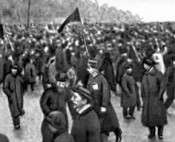
The all-Russian October political strike began
The all-Russian October political strike of 1905 was one of the most important stages of the Revolution of 1905—1907, the beginning of its culmination.
The struggle against legislative and deliberate Bulygin Duma (the manifest on its convocation was declared on August 6 (19) and the events of September in Moscow preceded the all-Russian October political strike. On September 19 (October 2) the economical strike of printers began in Moscow. They were joined by bakers, tobacco workers, furniture makers, tram drivers. Thus the strike had transformed from economical to political one. On September 23-25 (October 6-8) the conflicts between strikers and troops and Cossacks took place. Some of the strikers were wounded or killed. From September 26 (October 9) Moscow metal workers started their strike. The Councils of authorized printing workers, joiners, tobacco workers, metal workers and railway men had been formed. The printers of the capital had gone on sympathy strike at the call of Petersburg committee of RSDLP. The meetings and demonstrations took place in other cities and towns too.
Moscow committee of RSDLP had called for the universal strike at the roads of Moscow railroad junction from noon of October 7 (20). After Moscow the strike movement has spread over Petersburg and other cities and by October 13 (26) reached the main industry centers of the country. Factories, plants, transport, power plants, post, telegraph, institutions, shops and schools had closed. The number of strikers had reached 2 million people. The all-Russian October political strike had been developing under the following revolutionary slogans: ‘Down with Bulygin duma!’, ‘Down with tsar’s government!’, ‘Long live armed revolt!’, ‘Long live democratic republic!’. As a result of revolutionary activities of masses in October there were created the Councils of workers deputies in Petersburg, Ekaterinoslav, Kiev and later in other cities. Trade unions had been organized in Moscow, Petersburg, Yaroslavl, Kharkov, Tbilisi, Riga and Vilnius.
Tsar’s government had tried to suppress the political strike applying the repressions but finally it had been obliged to concede and to publish the Manifest of October 17, 1905. It acknowledged Duma’s legislative rights and gave civil liberties to people: personal immunity, freedom of speech, of conscience, of press, of assembly, of unions.
In the most part of the country’s regions and on railways the all-Russian October political strike ended on October 25 (November 7), 1905.
Lit.: Всероссийская политическая стачка в октябре 1905 года: в 2 ч. М.; Л., 1955.

